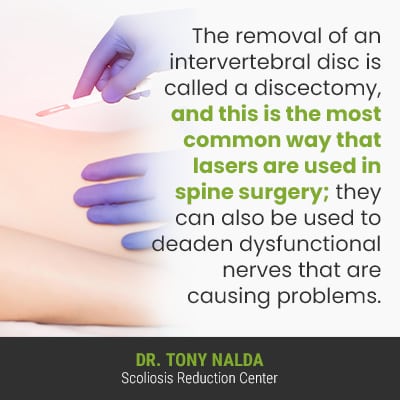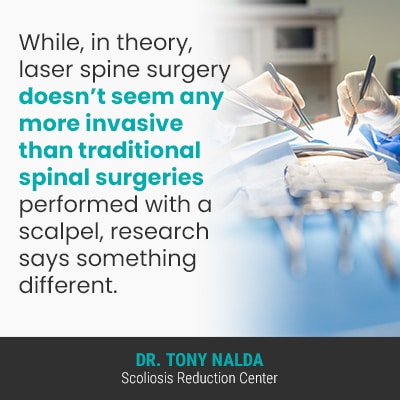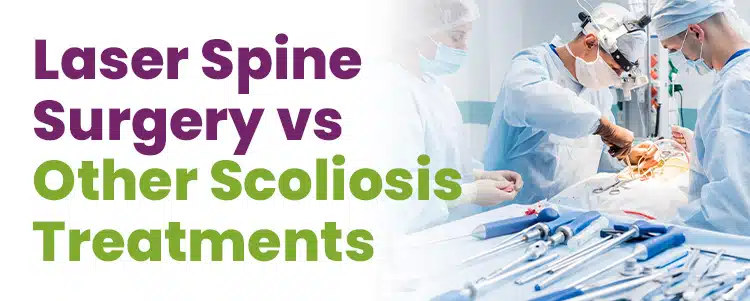For many years, the spine was seen as far too complex a structure to be operated on. As part of the central nervous system, the spine is involved in the function of virtually every system at work within the body. The success of lasers in eye-correction surgery suggested that, perhaps, they could be as useful in spine surgery, but the evidence is mixed.
Laser spine surgery uses a laser to produce enough heat to deaden damaged nerves, slice through tissue, remove discs, and cauterize blood vessels to reduce the risk of excessive blood loss; however, evidence says there’s not enough benefit to justify the use of lasers over traditional surgical methods.
The reality is that most cases of scoliosis can be treated non-surgically, but before explaining the benefit of a non-surgical treatment approach, let’s talk about the pros and cons of laser spine surgery.
What is Laser Spine Surgery?
Lasers have been used for years, in a number of ways, by the medical industry; from dermatology to the success of laser eye surgery, lasers have earned their place as an esteemed facet of medical technology.
The use of an intense beam of light to slice through tissue, rather than cutting with a scalpel, can reduce blood loss and offers precise results.
But what about the spine? In the context of scoliosis, we’re talking about a spine that has developed an unnatural sideways spinal curve that also rotates, making it a complex 3-dimensional condition.
Scoliosis and Surgery
While surgery is neither the best, nor only scoliosis treatment option available, for those on the path of traditional scoliosis treatment, spinal fusion surgery is a common recommendation.
Spinal fusion surgery is performed when a patient crosses into the severe classification and shows signs of further progression.
Scoliosis, as a progressive condition, has it in its nature to worsen over time, and this means the unnatural spinal curve is increasing in size, introducing more and more uneven forces to the body, and effects and symptoms are also increasing.
Scoliosis ranges from mild to very severe, and this is determined by a measurement known as Cobb angle, that indicates how far out of alignment a scoliotic spine is:
- Mild scoliosis: Cobb angle measurement of between 10 and 25 degrees
- Moderate scoliosis: Cobb angle measurement of between 25 and 40 degrees
- Severe scoliosis: Cobb angle measurement of 40+ degrees
- Very-severe scoliosis: Cobb angle measurement of 80+ degrees
So if a patient has progressed to become severe, or was diagnosed as severe, at this level, spinal rigidity is likely to be an issue, and when we’re talking about surgical treatment for scoliosis, we’re talking about removing discs and fusing the spine.
Laser Spine Surgery for Scoliosis
Spinal fusion is performed on patients with severe scoliosis that show signs of continued progression.
If a scoliosis is progressing, the most-tilted vertebrae at the curve’s apex are becoming more tilted, causing the spine to become more misaligned; a spine that’s not aligned is a spine that can’t function as it was designed, making it weak and more vulnerable to injury, not to mention causing varying levels of postural deviation and pain.
Traditional scoliosis treatment recommends spinal fusion as a means of stopping progression, and this is done by fusing the most-tilted vertebrae into one solid bone, eliminating movement (progression) in the area: the vertebrae can’t become more tilted.
Now, the spine’s vertebrae are separated by intervertebral discs that provide cushioning between adjacent vertebral bodies, give the spine structure, enable flexible movement, and act as the spine’s shock absorbers.
Basically, the spinal discs are key to optimal spinal health, strength, and function.
Discectomy and Nerve Deadening
In spinal fusion, it’s common that the disc in between adjacent vertebrae being fused is removed so they can become one solid bone.
Next, rods are commonly attached to the spine with pedicle screws to hold it in place, but the step before that is where lasers come in.

The removal of an intervertebral disc is called a discectomy, and this is the most common way that lasers are used in spine surgery; they can also be used to deaden dysfunctional nerves that are causing problems.
In most cases of laser spine surgery, the surgeon uses tiny incisions to access the affected area of the spine; these incisions are commonly made using tube-shaped instruments that can make precise and tiny punctures through which an endoscope (camera) can pass.
The camera then guides the surgeon to the desired area while muscle groups and ligaments are avoided; this reduces damage experienced around the area.
Next, the laser, with its intense heat, is directed at the area of the spine to either remove a disc(s) or burn problematic tissues and/or inflamed nerves.
So this all sounds positive, right? But what about laser spine surgery outcomes, and how much better is the use of a laser, than a traditional scalpel?
Laser Spine Surgery Outcomes

While, in theory, laser spine surgery doesn’t seem any more invasive than traditional spinal surgeries performed with a scalpel, research says something different.
According to the American Academy of Orthopaedic Surgeons, whose studies on the efficacy of laser spine surgery extended back to the 1980s, there is no benefit to using lasers in spine surgery; in addition, they can actually lengthen recovery time and are associated with some increased risk of complications.
Data showed that in patient groups comparing laser discectomy to more traditional types of microdiscectomies, the group receiving traditional spine surgery had less-lengthy recovery times and a reduced need for subsequent surgery: patients who received laser spine surgery had a 50-percent higher incidence of needing revision spine surgery.
Ultimately, the data revealed that despite the successful use of lasers in other medical fields, when it comes to spine surgery, the increased risk of thermal damage to the area, including tissues, nerves, bones, and disc cartilage can have far-reaching effects.
It should be stated that all surgical procedures come with their share of risks and potential complications, spine surgery, whether performed traditionally, or with the use of a laser, is no exception.
Fortunately, there is another non-surgical scoliosis treatment option with proven results.
Non-surgical Scoliosis Treatment: A Conservative Chiropractic-Centered Approach
Here at the Scoliosis Reduction Center®, I help patients avoid the need for invasive surgical treatment in the future, and while there are never treatment guarantees, early detection and intervention does increase the likelihood of treatment success.
Spinal fusion surgery is a costly, lengthy, and invasive procedure, whether performed with a laser or not, so why not work proactively towards preventing progression so patients diagnosed with mild or moderate scoliosis don’t become severe enough to warrant a surgical recommendation.
Scoliosis is simplest to treat while mild, before spinal rigidity has increased, making the spine less responsive to treatment, and before the condition has caused other effects such as a muscle imbalance in the spine’s surrounding muscles.
Scoliosis introduces a lot of uneven forces to the body, and as a structural spinal condition, it has to be impacted primarily on a structural level, in the form of a curvature reduction.
Chiropractic Care
I use condition-specific chiropractic care, including a number of techniques and manual adjustments, to work towards repositioning the curve’s most-tilted vertebrae back into alignment with the rest of the spine, thereby reducing the curve and addressing the condition’s underlying structural nature.
Physical Therapy
Through physical therapy, I can help patients increase core strength so their spines are optimally supported by its surrounding muscles, while addressing any related muscle imbalance.
In addition, physical therapy and the use of scoliosis-specific exercises can help improve brain-body communication for better posture and body positioning.
Corrective Bracing
Corrective bracing can be particularly effective on growing spines and can help augment corrective results achieved through other disciplines by pushing the spine into alignment.
Rehabilitation
Rehabilitating the spine further involves a series of custom-prescribed exercises to help patients establish a home-rehabilitation program; this can further stabilize the spine for long-term sustainable treatment results.
Remember, as a progressive condition, scoliosis is incurable, but it is highly treatable.
Conclusion
When it comes to spine surgery, there are a lot of risks and potential side effects and complications, and while spinal fusion as a scoliosis treatment option can help straighten an unnaturally-bent spine, it can do so at the cost of the spine’s natural strength and function.
When it comes to laser spine surgery, the data shows that despite the reduced risk of excessive blood loss, the related risk of thermal damage to sensitive areas of the spine can outweigh that benefit.
In addition, studies have shown that patients who have undergone disc removal performed with lasers have longer recovery periods and are significantly more likely to require revision surgery.
Once a spine is fused, it’s fused for life, and discs removed are gone forever, so the results of spine surgery are life-long, and as risks of complications are there, spine surgery should be considered carefully.
Fortunately, for those wanting to forgo a surgical recommendation, or who simply want to try a less-invasive treatment option first, conservative chiropractic-centered treatment offers a non-surgical alternative that strives to preserve as much of the spine’s natural strength and function as possible, throughout treatment and beyond.




